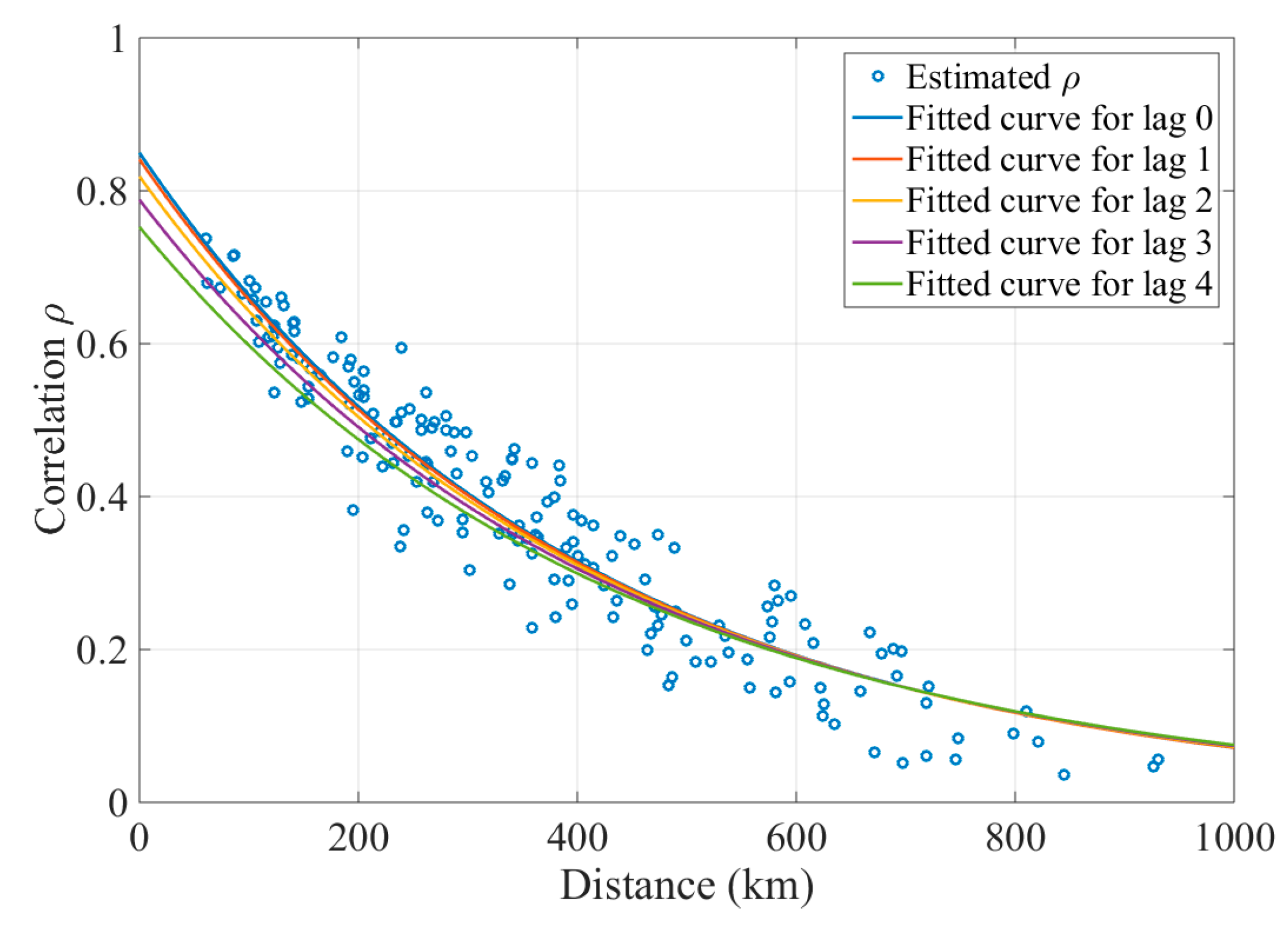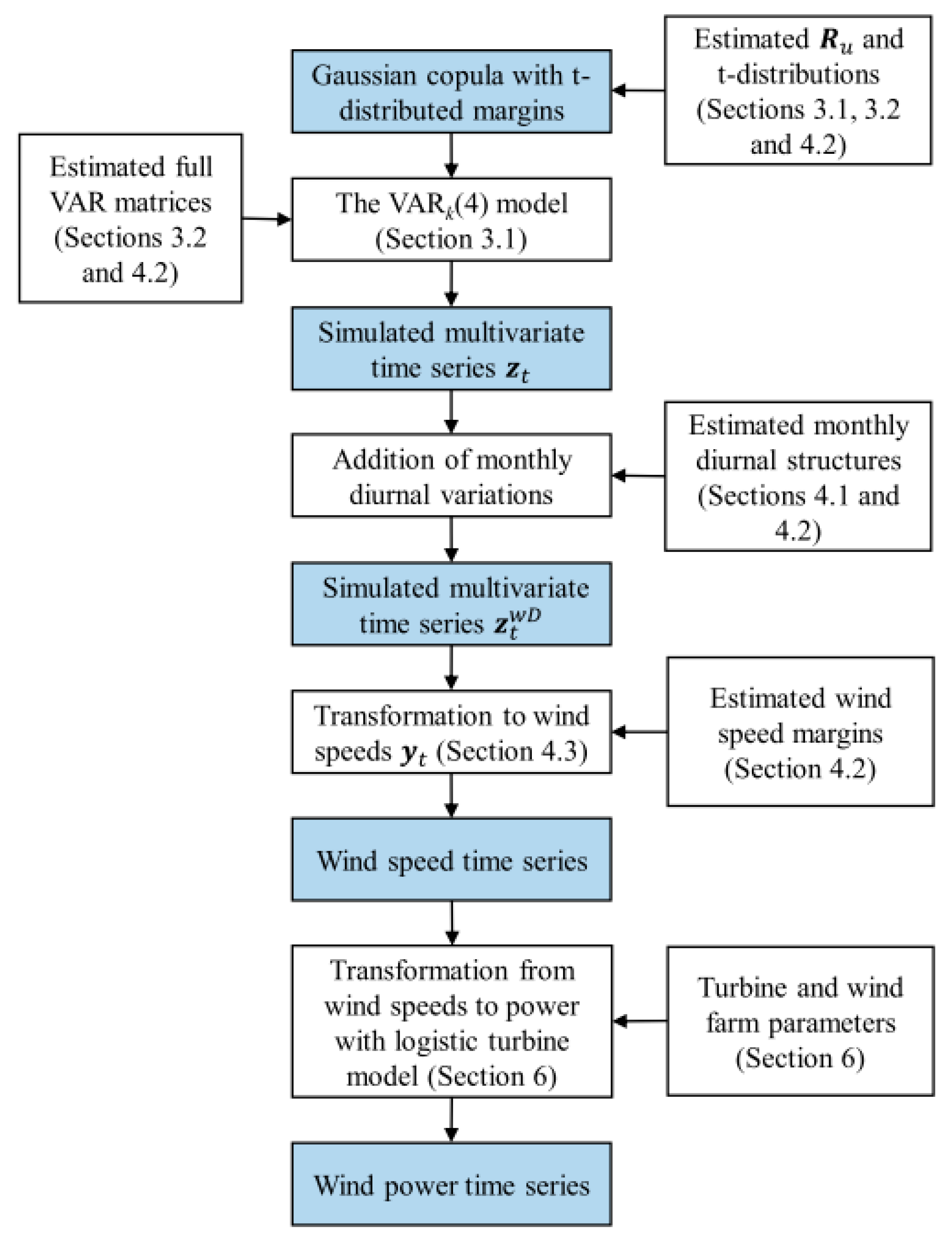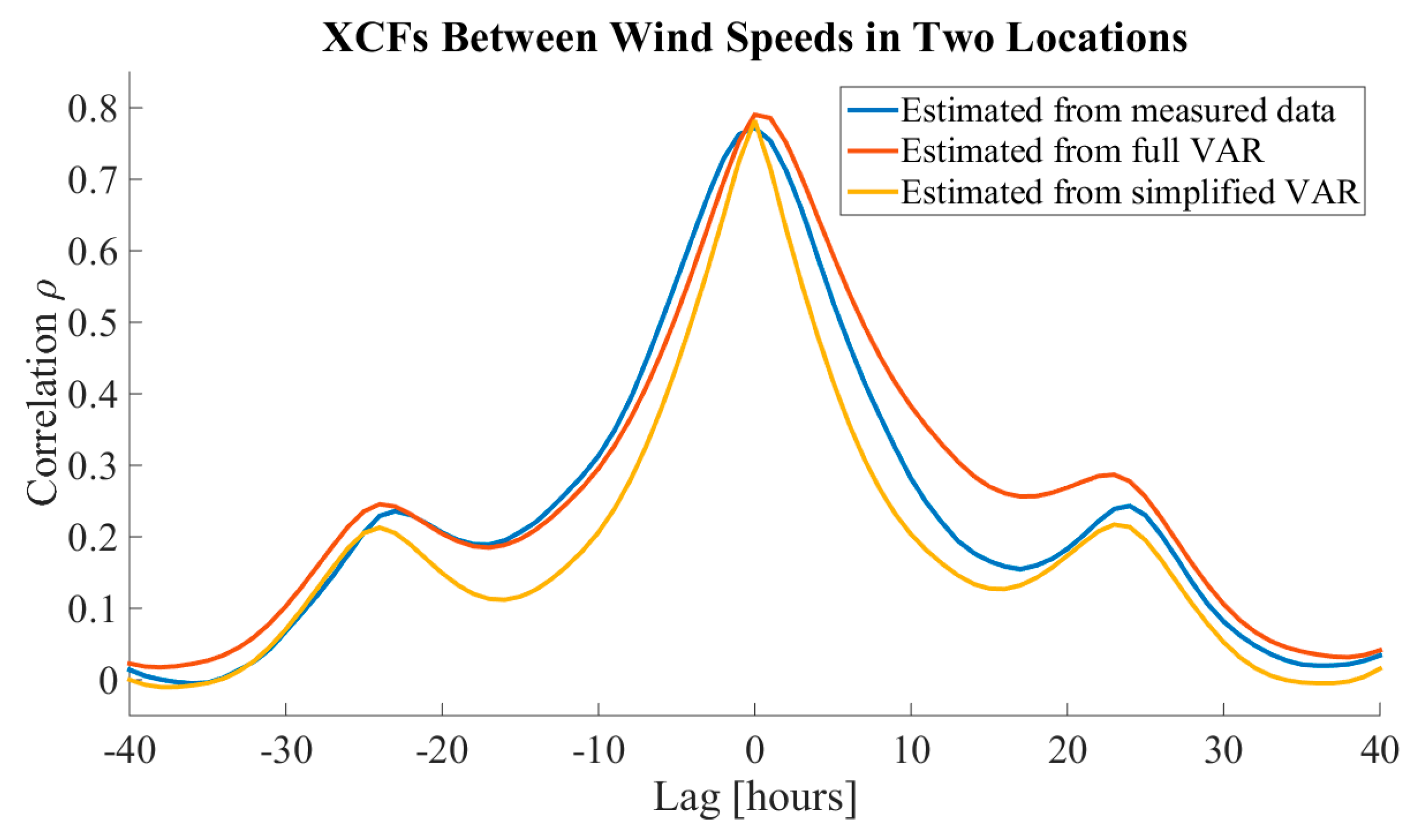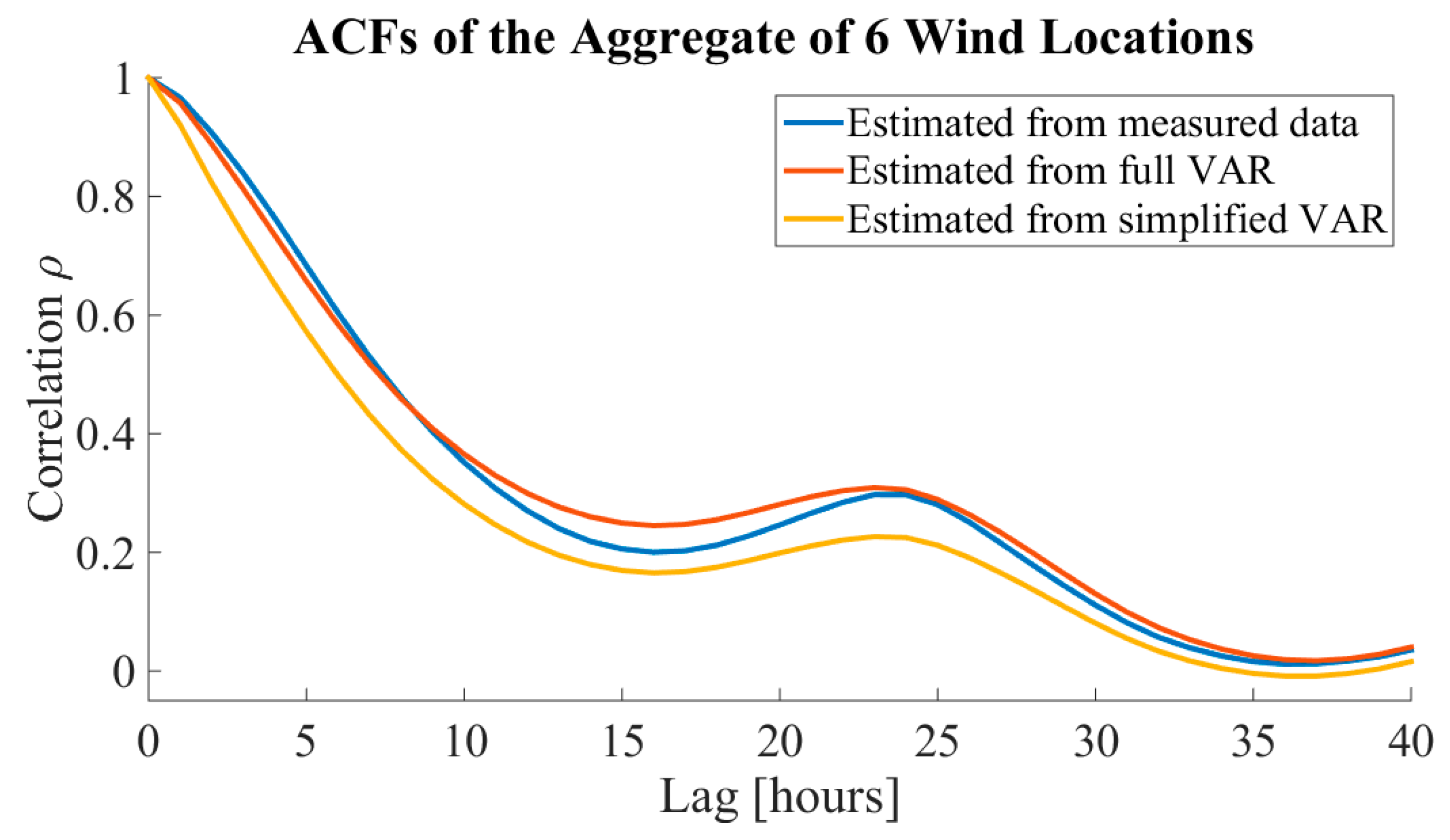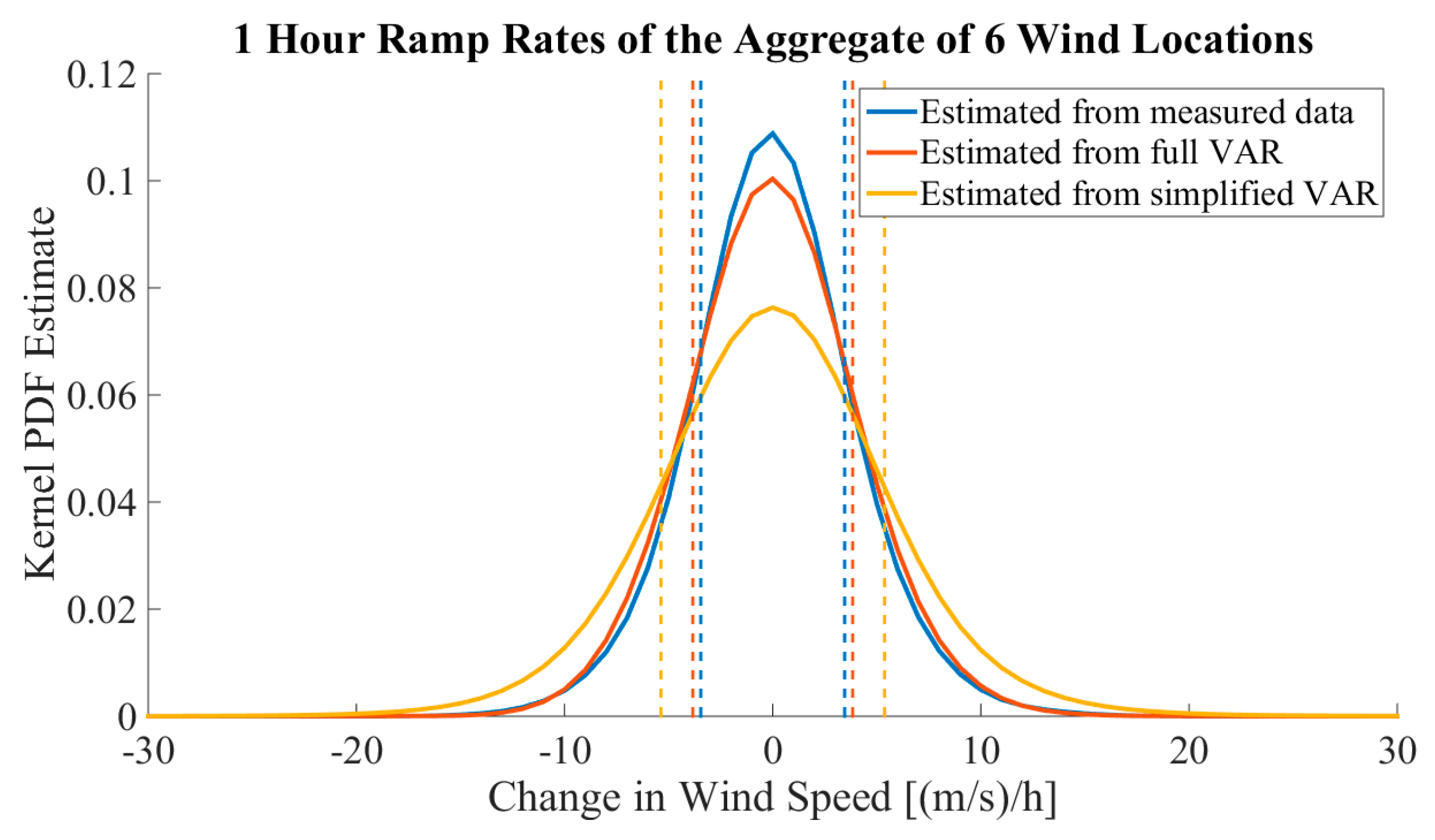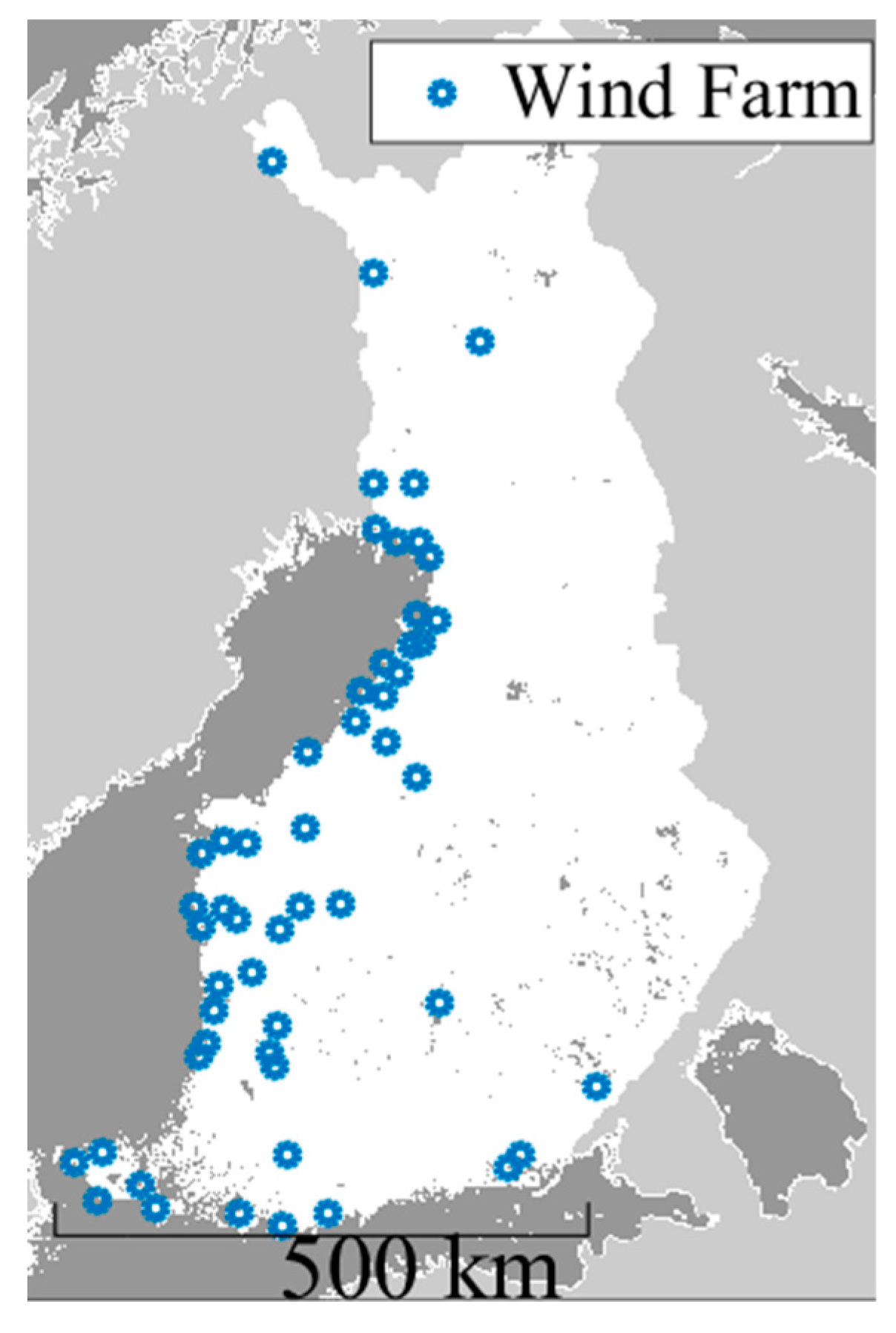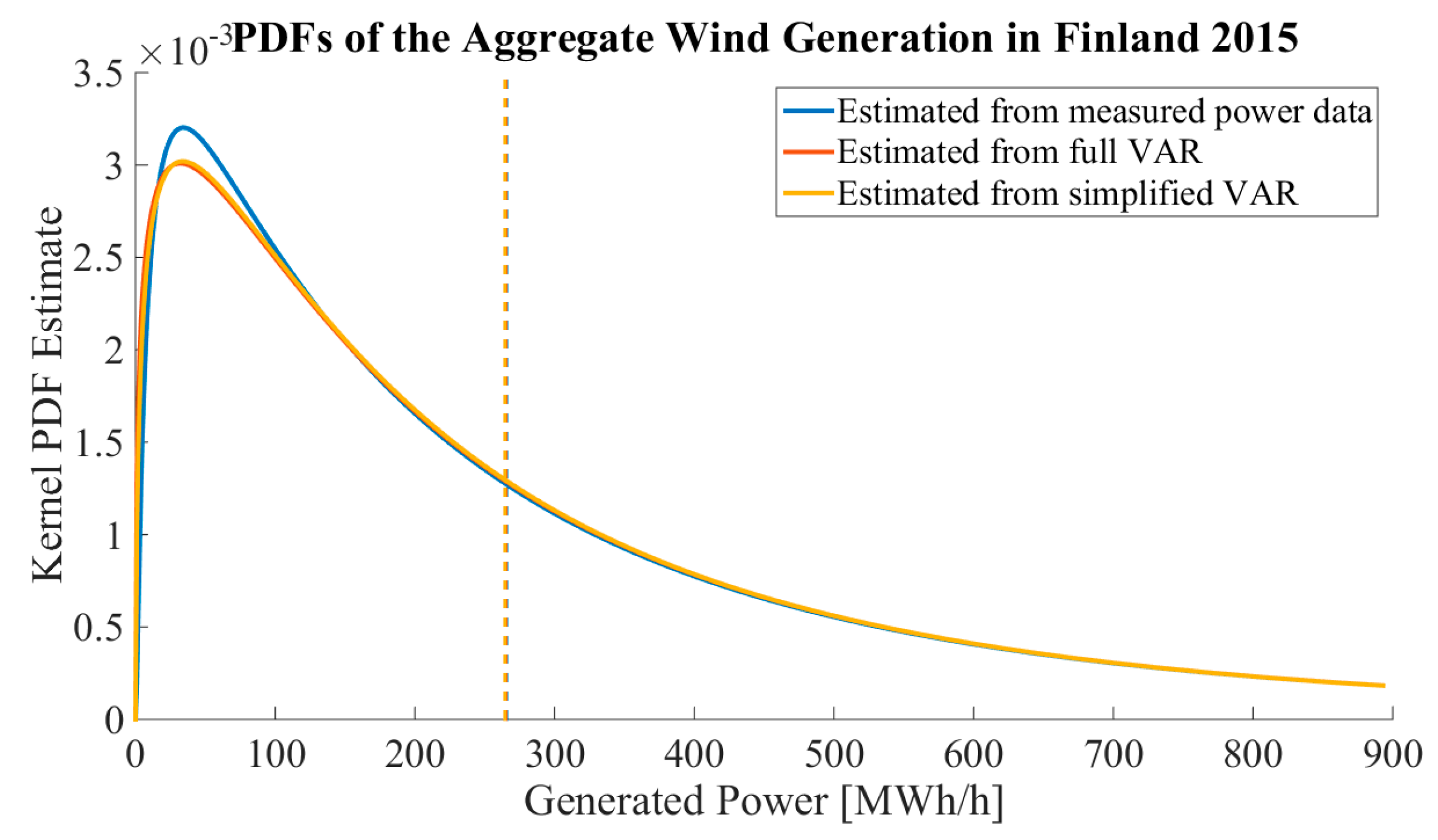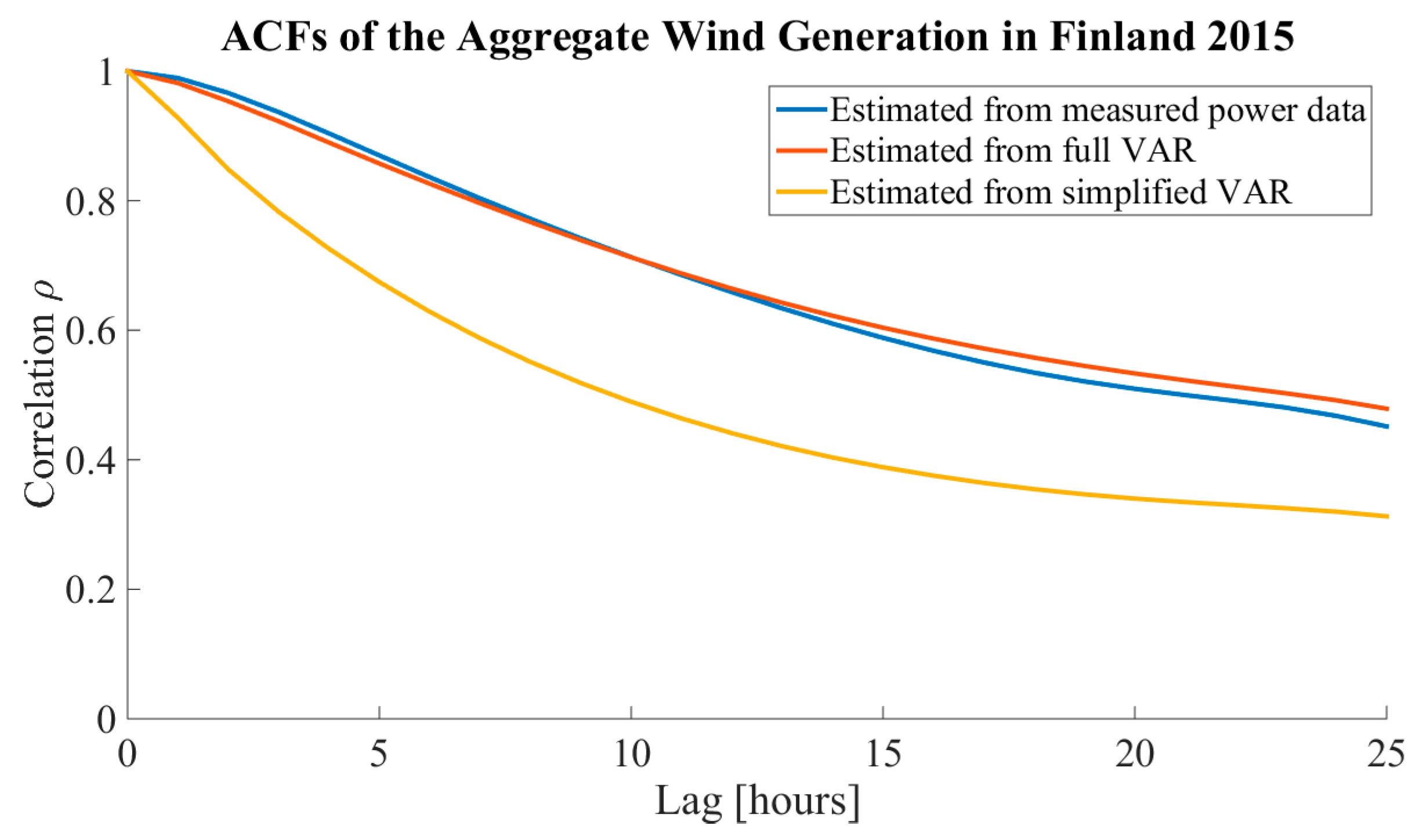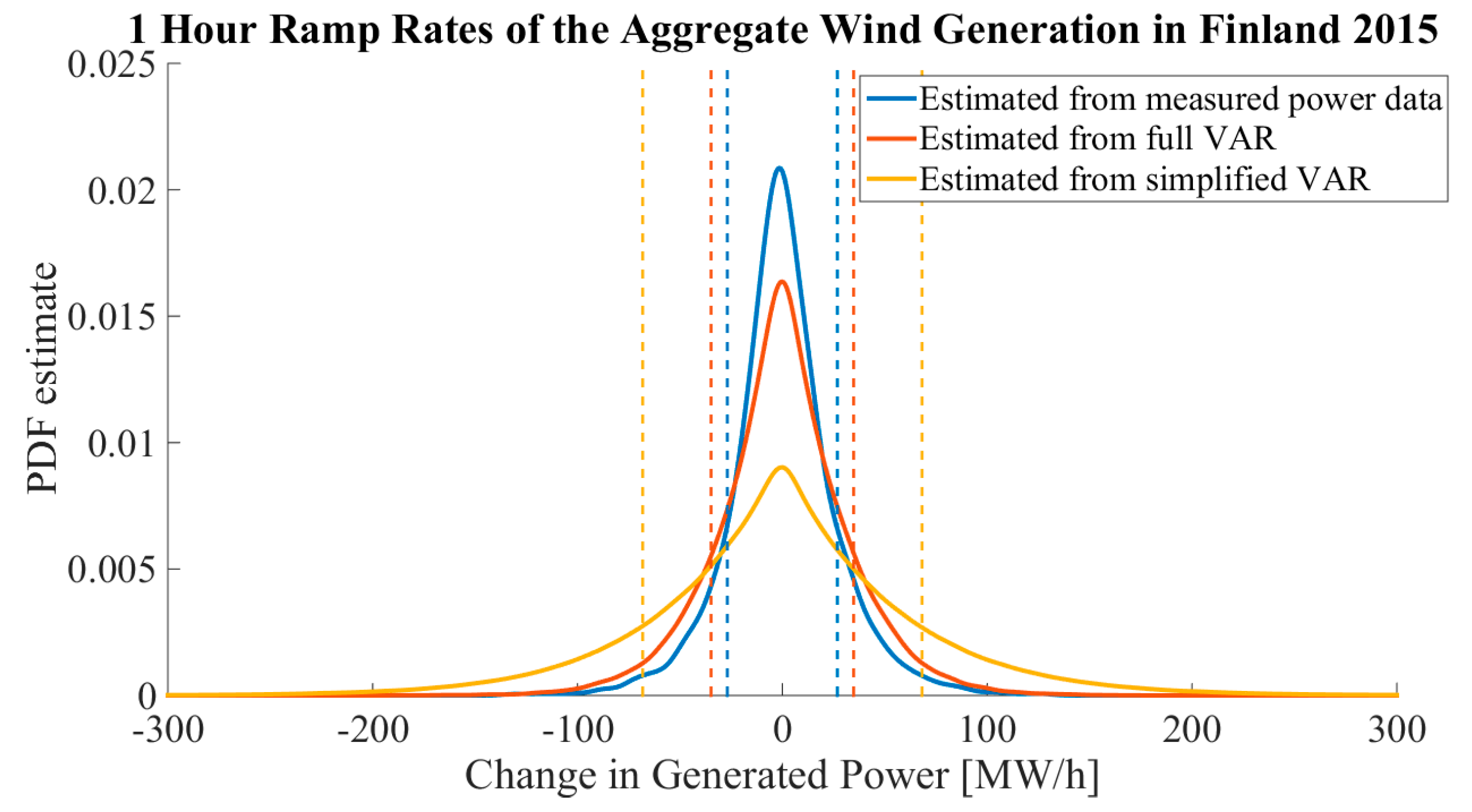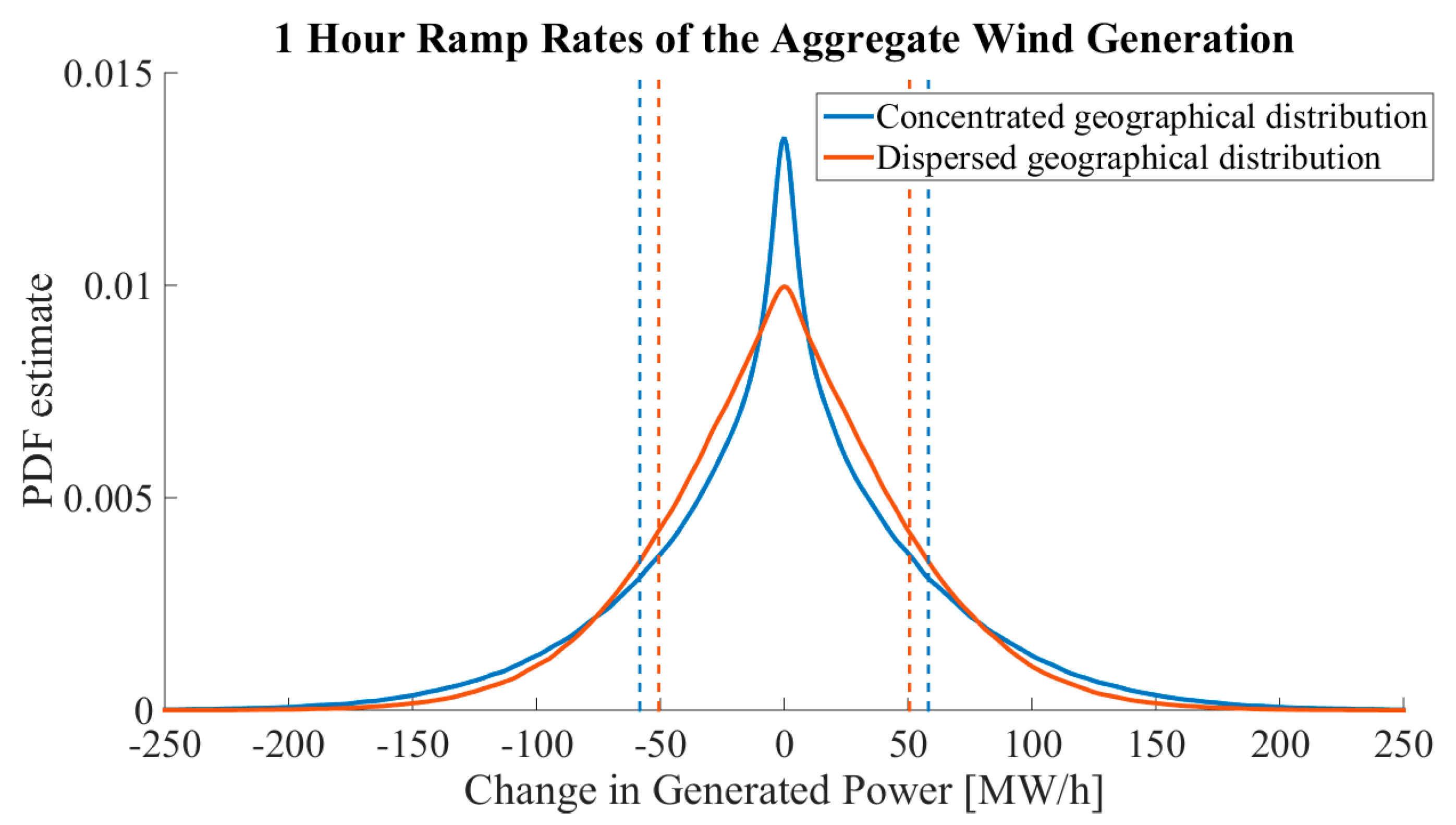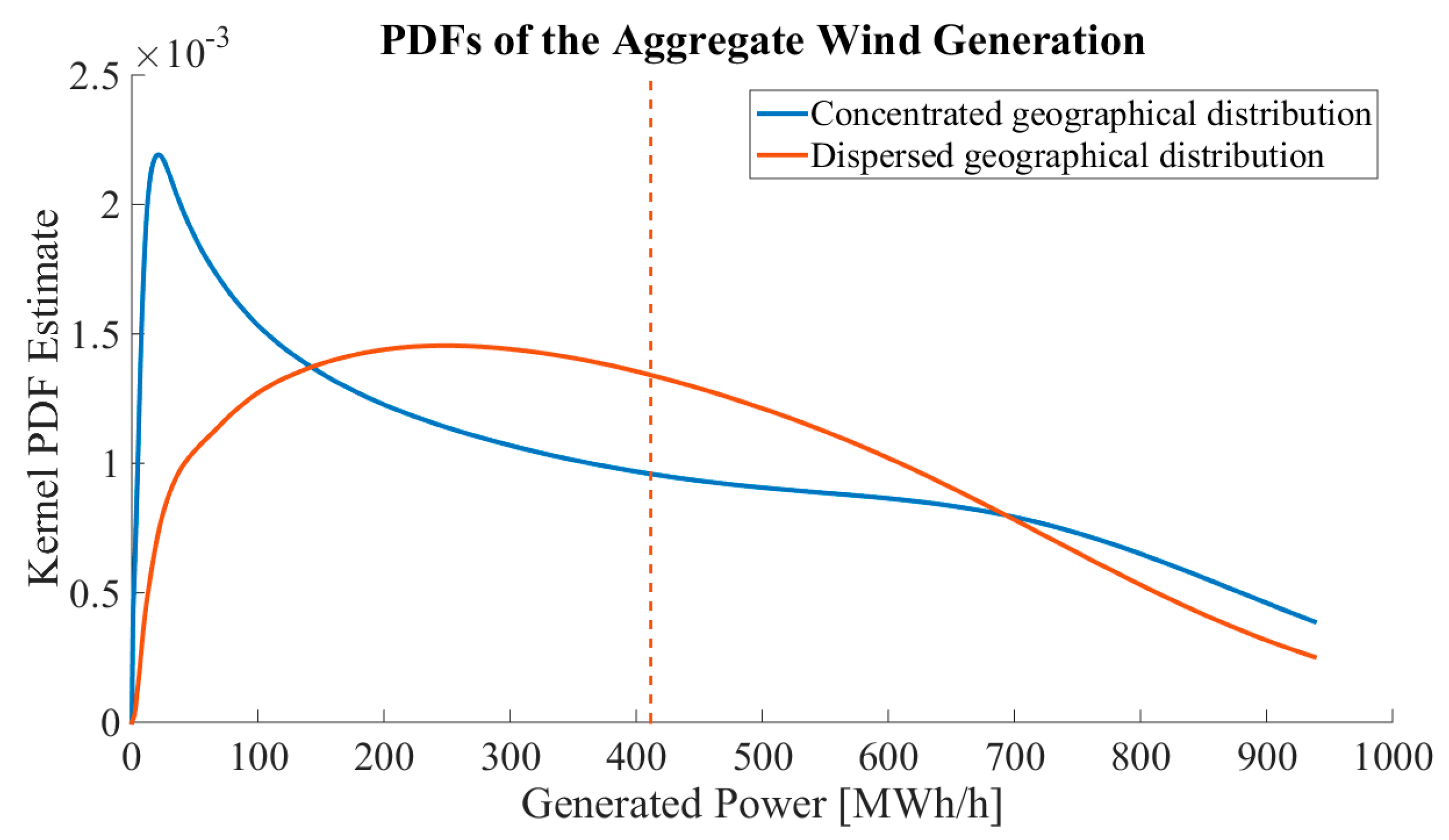1. Introduction
Wind power generation modeling has been a popular research topic in recent years since the installed wind generation capacities have been increasing rapidly in numerous countries. In the future, if CO2 emissions are to be reduced globally, an even larger share of electricity will have to be generated from renewable sources including wind power. However, the increasing penetration of wind power in the power systems gives rise to increasing variation and power ramps in the net power generation. Methods for analyzing the effects of a large number of WPPs on the power ramps in future power systems are, thus, becoming increasingly important.
Long-term stochastic simulation of wind power to analyze WPPs and their variability has been a popular approach [
1,
2,
3]. A frequently applied method in such modeling is to utilize Monte Carlo simulations for scenario analysis [
2,
3,
4]. It has been common to utilize copulas in the stochastic modeling of wind generation in multiple WPPs. This allows the separation of modeling from the dependency structures of the WPPs, i.e., the temporal and spatial correlations from the modeling of the marginal probability distributions, i.e., margins of the individual WPPs [
2,
3,
4,
5]. A similar modeling approach is also used in this paper.
It is relatively straightforward to fit a time series model, e.g., an autoregressive model, or an artificial neural network (ANN) to a dataset covering existing locations [
6,
7,
8,
9,
10], whereby the parameters of the time series model are estimated so that the important spatial and temporal characteristics of the data are modeled with some level of accuracy. However, as was shown in Reference [
11], it is not straightforward to estimate the coefficients of a vector autoregressive (VAR) model when modeling new locations without measurement data (i.e., non-measured locations). This is because, in a full VAR model (i.e., a VAR model where no coefficients are assumed to be zero), the individual coefficients of the model cannot be said to contribute either to only spatial correlations or to only temporal correlations [
8].
To overcome this challenge, one approach is to specify a simpler time series model where the coefficients of the model specify either temporal or spatial characteristics [
11,
12,
13]. For example, in References [
14,
15], the VAR model was simplified so that the non-diagonal components of the VAR coefficient matrices were assumed to be zero (i.e., the simplified VAR model). This allows for a straightforward estimation of the model for new locations. This paper will show, however, that such a simplification may result in significant errors in simulated ramp rates. To tackle this problem, the use of the full VAR model is proposed along with a new estimation method that is suitable for modeling new locations.
In previous research, a simplified VAR model has been unable to model the shape of the cross-correlation function (XCF) between two WPP locations [
11,
12]. Failure to model the XCFs between individual WPPs correctly, especially near lag 0, affects the modeling of the autocorrelation function (ACF) of the aggregated wind power generation, which will be shown in this paper. However, the proposed full VAR model can capture the correct shape of the spatial correlation structure between two locations with greater accuracy, which is important for the assessment of the aggregated power generation of multiple WPPs. In addition, the proposed VAR model can be estimated using only wind speed measurement data, which is not the case with many previously published approaches, such as in References [
12,
16].
The simplified VAR model is also used in wind and solar forecast simulations [
17,
18,
19]. While this paper focuses on the simulation of wind generation, the presented full VAR model can also be considered for forecast simulations, where the use of a simplified time series model can have similar drawbacks, to those demonstrated in this paper for wind generation.
Furthermore, for the wind power generation model used to transform the simulated wind speeds to wind power instead of a commonly used third degree power curve [
20], a state-of-the-art approach based on logistic functions [
21,
22] was used. The utilized approach allows for a deterministic estimation of detailed turbine specific power curves from the turbine data sheet parameters, which is essential when modeling non-measured WPPs.
To summarize the contribution to the literature, the proposed VAR model enables a more accurate modeling of both the temporal correlations in individual WPPs and the spatial correlations between the WPPs in new locations. It is demonstrated that the autocorrelations of the aggregated power generation depend on the spatial correlations between the individual WPP locations, which can be modeled accurately with the full VAR model. Consequently, the proposed model can be utilized in the analysis of aggregated generation in future energy systems, including the detailed analysis of wind power ramp rates. It is shown that, with the new methodology, the estimation of the ACF of the aggregated generation and ramp rate probability distribution are much more accurate than with the previous approaches [
12,
15] that utilized the simplified VAR model.
This paper is organized as follows.
Section 2 demonstrates the relation between the autocorrelations of an aggregated time series and the cross-correlations of the individual time series.
Section 3 presents the proposed full VAR model and the specification of the model parameters for the analysis of temporal and spatial dependency structures.
Section 4 describes the estimation data and the estimation of the simulation parameters and illustrates the overall structure of the methodology to model non-measured WPP locations.
Section 5 presents the simulation results for six out-of-sample wind speed locations.
Section 6 describes the power generation model used in the power simulations.
Section 7 introduces the simulation results for out-of-sample modeling of the aggregated wind power generation in Finland in 2015.
Section 8 presents the results for a case study assessing the impact of the geographical distribution of the WPP locations on the wind power ramp rates and
Section 9 concludes the paper.
2. The Impact of the Cross-Correlations of Individual Time Series on the Autocorrelations of Their Sum
This section shows that the autocorrelation of a sum of multiple time series depends on the cross-correlations between the individual time series. Consequently, it highlights the importance of using a full VAR model in the modeling of aggregated wind power generation, since it is able to model the shape of the XCF near lag 0, which is shown in
Section 5.2.
Next, a simple example to demonstrate the dependency between the cross-correlations of two stationary time series
and
and the autocorrelation of their sum
is presented for lag
h = 1. The autocorrelation of the aggregated time series
can be specified for lag
h = 1 as shown in the equation below.
On the other hand, according to the properties of covariance
and the variance of a sum of two random variables is given by
Using Equations (2) and (3) and the relation between covariance and correlation
, Equation (1) can be expressed with the correlations between
and
as shown below.
where
is the standard deviation (STD) of the corresponding time series. As shown in Equation (4), the cross-correlations between time series
and
with lags −1 and 1 (as XCF is asymmetric with respect to 0) affect the autocorrelation of the aggregated time series
at lag 1.
Consequently, a similar dependency between the cross-correlations of individual time series and the autocorrelations of their aggregate occurs with multiple time series and for all lags. Hence, it is crucial to be able to model the cross-correlations between individual non-measured WPP locations as accurately as possible in order to capture the correct behavior of the ACF of the aggregated time series for the WPP locations.
4. The Simulation of Non-Measured WPP Locations
This section presents the overall Monte Carlo (MC) simulation procedure for the modeling of non-measured WPP locations. First, the used data and the marginal distributions are described and, then, the estimation of the simulation parameters is presented. Lastly, the structure of the MC simulation procedure is presented step by step.
4.1. The Data and the Marginal Distributions
This paper utilizes the same wind speed datasets for the estimation of the VAR model as seen in References [
12,
15]. The datasets consist of hourly wind speed measurement time series from 12 high altitude locations (height from 74 to 150 m above the surrounding ground level) and 19 low altitude locations in Finland. The length of the measured time series varies from one to three years depending on location. It should be noted that the low altitude measurement data are used only in the estimation of the spatial and spatiotemporal correlations (as all 19 locations have the same measurement period of three years), which is explained in
Section 4.2.
Empirical cumulative distribution functions (ECDFs) [
3,
16] are applied as margins for the wind speed measurement locations. The wind speed data from
k measured locations denoted as
, are transformed to data with normally distributed margins
(where
wD denotes
with day structures, meaning that the monthly diurnal variations are still present in the data). The transformation to Gaussian data is performed by using the probability integral transformation.
where
is the inverse cumulative distribution function (CDF) of the standard normal distribution and
is the estimated ECDF margin for location
i.
Next, the monthly diurnal structures, i.e., the day structures, are estimated from
by calculating mean values for each hour of the day of each month. These means are subtracted from
and
is obtained. The VAR model is then estimated from
. A similar approach has been used in Reference [
15].
4.2. The Estimation of the VAR Model and Simulation Parameters for Non-Measured WPP Locations
The VAR model identification was achieved by assessing the ACFs and partial autocorrelation functions (PACFs) of , which indicated that a suitable order for the VAR model was p = 4. The adequacy of the VARk(4) model, fitted for , was verified by checking that the model residuals had no statistically significant ACF, PACF, or XCF values (except XCF with lag which is acceptable). The margins of had too high kurtoses in all estimation locations to follow a normal distribution. Hence, t-distributions were fitted for the margins of the residuals.
When p = 4, the autocovariance matrices are needed for lags for the estimation of the VAR coefficient matrices, which is shown in Equation (13), and for the estimation of the covariance matrix of the error terms , which is shown in Equation (14). The autocovariance matrices are obtained from the autocorrelation matrices with Equation (7). The STDs for the diagonal matrix D for new locations, which are used to convert to in (7), are averages of the STDs calculated from used in the estimation.
The autocorrelation matrices specify both the temporal and spatial correlations of For the non-measured WPP locations, the temporal correlations (the diagonal components) of for the lags are the average values of the ACFs calculated from the components of used in estimation.
The spatial and spatiotemporal correlations (the off-diagonal components) of
are estimated by utilizing the distances between the non-measured WPP locations, which was done in [
15].
Figure 1 illustrates the correlations (for
h = 0) estimated from
calculated for the 19 low altitude wind speed measurement locations against the distances between the measurement locations represented as blue circles.
Figure 1 also shows the five curves fitted for these spatial and spatiotemporal correlations for lags
. These five curves linking the distances between the locations to the corresponding spatial and spatiotemporal correlations are used to estimate the off-diagonal elements of
for lags
for the new locations.
The covariance matrix
, which is estimated and shown in
Section 3.2., is modeled as a Gaussian copula. The mean value of the degrees of freedom from the fitted
t-distributions (5.8068) is used to specify the margins of
for the non-measured WPP locations.
The correlation matrix of the error terms
, which is derived from
, is used as the correlation matrix for the Gaussian copula,
. This approximation showed very similar
and
in the simulations and gave valid results in the applications, which are shown in
Section 5 and
Section 7.
The monthly diurnal variations, i.e., the day structures, are estimated from
and used in the estimation, which is described in
Section 4.1. The averages of the estimated day structures are used for the non-measured WPP locations. Weibull distributions commonly used to describe the wind speed conditions in a specific location [
12] are applied as margins for the new WPP locations. The Weibull distribution parameters for each new location are obtained from the Wind Atlas database [
24].
4.3. The Estimation of the VAR Model and Simulation Parameters for Non-Measured WPP Locations
The simulation procedure is illustrated in
Figure 2. The procedure begins with the drawing of a sample from the Gaussian copula for the
k simulated WPP locations for the length of the simulation and transforming the margins to
t-distributions.
Next, the correlated
t-distributed random numbers are used as innovations for the VAR
k (4) model. The model produces a simulated multivariate time series
with the appropriate spatial and temporal dependency structures. Then the estimated monthly diurnal structures are added to the simulated data, which yields
. As
Figure 2 shows, the simulated
is further transformed to wind speeds with the formula below.
where
is the resulting simulated wind speed in location
i at time
t,
is the estimated inverse CDF of the Weibull distributed wind speed margin for location
i, and
is the CDF of the standard normal distribution.
The last step in the procedure is to transform the multivariate wind speed time series
to the power time series for each individual WPP using the wind power generation model presented in
Section 6. The power time series for each WPP can be aggregated to a single time series depicting the aggregated wind power generation for the whole simulated system.
6. The Wind Power Generation Model
This section presents the power generation model to transform the simulated wind speeds to generated power. The paper utilizes an improved state-of-the-art power generation model based on a logistic function in the methodology [
21]. For the wind turbine model, a three-parameter logistic power curve estimated using a deterministic process is utilized. This is proposed in Reference [
22], where it is shown to perform better than other approaches. This particular approach was chosen as the parameters of the logistic function, which can be obtained using only information available from the wind turbine data sheets without any requirements for measured power generation data. The implemented logistic function to transform the wind speeds to generated power can be written using the formula below.
where
is the rated power of the wind turbine,
u is the wind speed,
is the wind speed in the inflection point, which is the point in the power curve where the gradient of the power is at its maximum, and
s is the slope of the power curve in the inflection point, i.e., the value of the gradient. Equation (17) is applied between the specific cut-in and cut-out speeds specified for a turbine. An example of the shape of the power curve produced by the utilized turbine model is illustrated for the Gamesa G128 4.5 MW wind turbine [
25] in
Figure 6.
In addition, the wake effect, i.e., the slowed down and turbulent wind caused by turbines in the downwind direction inside a wind farm, is considered using a wake coefficient, which is presented in Reference [
26], before aggregating the power generation of the individual turbines to give the power generation of the wind farm. The wake coefficient for a wind farm is determined based on the number of turbines in the farm and the distance between the turbines. When the farm topology is not known, e.g., with new wind farms, a regular array topology with the distance of nine times the rotor diameter between the turbines is assumed. A similar approach was used with new wind farms in Reference [
12].
8. The Comparison of the Ramp Rates of the Wind Generation with Different Geographical Distributions
In this section, two wind power generation scenarios are studied to analyze the effect of geographical distribution of the WPP locations on the aggregated wind power ramps. Two distinct geographical distributions of the WPPs are considered; dispersed and concentrated.
8.1. The Simulation Setup for the Scenarios
The two wind power generation scenarios consist of 12 WPPs with 20 Gamesa G128-4.5 turbines with 4.5 MW nominal power [
25] in each, which results in 90 MW of total installed capacity per WPP. Hence, the aggregated installed capacity in both scenarios is 1080 MW. The hub height of the wind turbines is considered to be 140 m for all turbines.
In the first of the two scenarios, the locations of the WPPs are geographically dispersed and, in the second scenario, the locations are geographically concentrated. In the concentrated scenario, the average distance between the WPPs is 59.6 km and, in the dispersed scenario, the average distance is 285.6 km. In both scenarios, the WPPs are considered to be located in Southern and Central Finland.
To enable a more straightforward comparison of the scenarios in terms of the impact caused by the geographical distribution of the WPPs on the wind power ramps, the generation conditions are fixed in each WPP location. This means that the Weibull parameters describing the wind speed conditions are similar for each WPP in both scenarios. Consequently, the annual generated energy and the hourly mean generation are very similar for both scenarios. The utilized Weibull parameters (
A = 8.5 and
B = 2.3) are the averages of the parameters obtained for a height of 140 m from the Finnish Wind Atlas database [
24] for the WPPs in
Section 7.
8.2. The Simulation Results for the Scenarios
This section presents the aggregated MC simulation results for the two scenarios. A total of 100 MC simulation runs were performed with an hourly time resolution, resulting in
simulated samples for each WPP in both scenarios. The simulation results for the aggregated power generation are illustrated for one-hour ramp rate PDFs in
Figure 11 and for power generation PDFs in
Figure 12.
Table 2 presents the numerical results obtained for the scenarios.
As
Figure 11 shows, the geographical distribution does have a significant impact on the shape of the one-hour ramp rate PDFs. It is clear that the dispersed scenario yields smaller hourly volatility for the one-hour ramp rates compared to the concentrated scenario. The power generation PDFs in
Figure 12 show that, in the geographically dispersed scenario, the hourly generation has smaller volatility and fewer hours with a very large or small aggregated generation, which is in line with previous research, as shown in References [
11,
12,
14,
16].
In addition, according to
Table 2, the yearly energy and hourly mean generation are similar in both scenarios, which is expected. In the geographically concentrated scenario, extreme generation events, with aggregated generation less than 20% or more than 80% of the installed generation capacity, are more likely (also visible in
Figure 12). In addition, the STD of the aggregated generation is notably smaller in the geographically dispersed scenario. The probabilities for ramp rates being more than 10% or 20% of the installed capacity are larger with the concentrated distribution, which is also visible from
Figure 11. In addition,
Table 3 presents the STDs of the ramp rates for different ramp lengths from 1 hour to 10 hours. The ramp rates of the dispersed generation are notably lower, regardless of the length of the ramp rate. The differences between the two scenarios increase when looking at longer ramp lengths.
To summarize, the STDs of the ramp rates and the probabilities for very large up or down power ramps are notably smaller with the geographically dispersed scenario. Hence, the dispersed placement of WPPs results in smaller ramp rates and, thus, easier manageability of the power ramps from the perspective of the power system operator.
9. Conclusions
This paper has presented an improved VAR model based methodology to model wind power generation in multiple new WPP locations. It was shown that the detailed modeling of temporal correlations in individual WPP locations and the spatial correlations between the WPPs are essential in order to properly model the dependency structures of the aggregated power generation. It was demonstrated that the proposed model is able to model the correlational structures with required accuracy for the analysis of aggregated wind power generation and power ramps. Furthermore, an estimation method suitable for the modeling of new WPP locations was presented for the proposed full VAR model.
The ability of the proposed methodology to model the aggregated generation of non-measured WPP locations was verified both in wind speed and wind power domains against measured data. An aggregate of six out-of-sample wind locations and the aggregated wind power generation in Finland in 2015 were modeled and the simulations compared well with the measured data. The model was able to simulate aggregated time series with similar statistical qualities and dependency structures to those present in the measured data in both studied cases and was found to be superior to the simplified VAR model.
The presented VAR model extends the applicability of the existing methodology to cover detailed long-term simulations and scenario analyses of the volatility of the future wind power generation including wind power ramp analysis. The detailed analysis of power ramps and especially the assessment of the impact of new WPPs on the aggregated power ramps are crucial topics for both transmission system operators and power producers.
Lastly, a case study assessing the impact of the geographical distribution of the WPP locations on the aggregated ramp rates was presented. The paper quantifiably verified that the impact of the geographical distribution is significant on the aggregated ramp rates and that dispersed geographical distribution of wind turbines results in smaller volatility in aggregate generational output.
